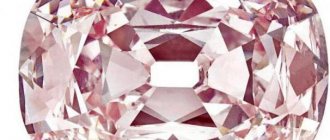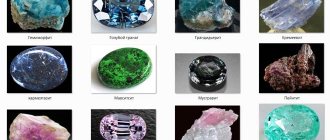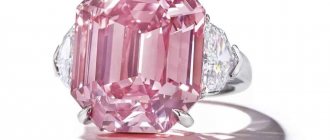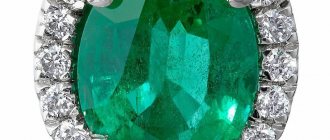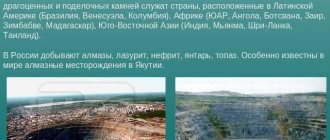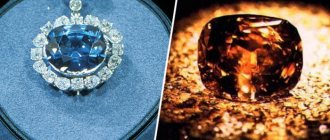The world's largest crystals (PHOTO, VIDEO)
The Cave of Crystals (Cueva de los Cristales) is a natural formation lying at a depth of 290 meters underground. Its uniqueness is represented by the interweaving of huge transparent crystals of selenite (a crystalline type of gypsum), reaching record sizes. Giant formations spent several hundred thousand years growing in an underground cavity filled with water. Geologists call this miraculous Mexican miracle the “Sistine Chapel of Crystals,” thereby hinting at its beauty and uniqueness.
Cave of Giant Crystals in Mexico
The cave of giant crystals was accidentally discovered in 2000 by two miner brothers named Sanchez, who were exploring a new drained passage in the shaft of a silver-lead mine for mining. Although the miners Juan and Pedro were accustomed to a wide variety of formations, the picture that appeared before their eyes amazed them with its beauty - when the lantern beam illuminated the underground hall, it was reflected many times in different directions, as if everything here was strewn with pieces of a broken mirror.
Located at a depth of three hundred meters, the cave contains impressive crystals in its depths, which, like giant rays, cut the space lengthwise and crosswise, creating a truly fantastic spectacle. The largest of them reaches 11 meters in length, 4 meters in diameter and weighs 55 tons, making it the largest naturally occurring crystal formation ever found on planet Earth. The crystals here are sharp as a razor blade, some of them resemble the mouth of a shark, fancy candles or the huge eyes of a fairy-tale character.
Two explorers in the Cave of Crystals, Mexico
Water is constantly pumped out of the caves, because... if the equipment stops, the space will flood again. Scientists have developed a special program, the Nike project, focused on protecting natural objects from the effects of negative factors. The fact is that crystals degrade in air, so researchers strive to quickly record all the data on a unique geological find before it collapses.
A scientist studies a selenite crystal in a Mexican cave.
Selenite crystals began to form in an underground cave about half a million years ago. Favorable conditions for growth were formed by a number of factors - the city of Nike lies on an ancient fault, due to which an underground magma chamber formed in the chamber under the cave. The hot magma heated the groundwater, causing it to become saturated with minerals, including large amounts of gypsum. Soon the hollow space of the cave was completely filled with hot water rich in minerals and remained in this state for more than five hundred thousand years. Throughout this time, the temperature of the mineral liquid did not drop below 50 °C, which allowed microscopic selenite crystals to form and grow to incredible sizes. Due to ideal conditions, they grew continuously until miners pumped out the groundwater to explore the cave further. If crystals are placed in an environment that has been “native” to them for many millennia, they will continue to grow.
Huge crystals in a cave in Mexico
The Cave of the Giant Crystals remains very hot due to its proximity to the deep underground magma chamber. The air temperature inside the cavity reaches +58 ºС with a humidity of 90-100%. Staying in a cave without special protective suits can lead to severe dehydration within 10-15 minutes. Such extreme conditions significantly complicate the process of studying the object by scientists. They are forced to wear cooling suits and a special backpack with a respirator that allows them to breathe in cold air. Even with all the equipment, the time spent in the cave should not exceed 30 minutes at a time.
Researcher in the Cave of Giant Crystals
The first cave to be discovered in the Nike mine complex in 1910 was at a depth of 120 meters, which was called the “Cave of Swords.”
Cave of Swords in the Nike Mine, Mexico
It is filled with transparent light crystals, not exceeding a meter in length. Most likely, the temperature at this depth dropped much earlier, stopping the growth of selenite formations. Crystals from this cave can be seen in many museums around the world. 90 years later, the world learned about the famous Cave of Crystals.
Cave of Giant Crystals in Chihuahua, Mexico
It is a horseshoe-shaped depression located inside a limestone rock. The floor of the cave is dotted with transparent blocks, from which a huge 11-meter crystal protrudes. During drilling in 2009, another hall was found at a depth of 150 meters, called the “Ice Palace”.
Ice Palace
Its selenite formations are much smaller than those of its “neighbors”, and are covered with thin thread-like growths and small formations reminiscent of “cauliflower”.
Huge selenite crystals in the town of Nike in Mexico
Selenite is one of the most amazing forms of gypsum, often forming into small transparent compounds. Only occasionally does it present itself as giant crystals, as in the cave of the Nike mine complex. The mineral was named after the Greek goddess, the Moon, due to its soft white color. This form of gypsum is believed to have many healing and metaphysical properties.
Selenite crystals that look like giant rays
Due to its enormous scientific and aesthetic importance, the natural wonder in Mexico is protected, and access to the caves is open only to scientists and researchers. However, the attackers managed to break into the locks several times in order to extract the mineral. Even at the very beginning of its history, when the object was not yet protected by a metal door, many crystals were repeatedly destroyed - some visitors tried to break off a piece as a souvenir, others pursued commercial purposes.
Explorer in the Cave of Crystals, Mexico
Studying the cave, which has been sealed for so long, allows geologists to explore and analyze unique data that makes it possible to see how the earth's crust gradually developed over many millennia. In addition to geologists, this natural formation is of considerable interest to biologists, since microscopic cavities in crystals can store ancient microorganisms.
Cave of Giant Crystals in Nike, Mexico
In 2011, the Discovery Channel prepared a project called “Nike. On the other side of the Cave of Crystals." The program talked about computer modeling and mathematical processing, which suggested the possibility of the existence of other similar caves, but further research could lead to the destruction of the crystals.
Short video (2:39) from Discovery. English.
Once all surrounding ores have been mined, the water pumps will be turned off, causing the caves to flood again and return to their previous state.
Scientist explores the Cave of Giant Crystals, Mexico
Let's just look at the photos.
Amazing cave of giant crystals in the Mexican state of Chihuahua
Cave of giant crystals in the Nike mine complex, Mexico
Cave of Crystals in Nike, Chihuahua, Mexico
Beautiful selenite crystals in the Nike mine, Mexico
Cave of giant crystals in Naica, Mexico
Source
And for dessert, a heart-warming film about this from National Geographics (45 minutes)
All the best to us 
Source: cont.ws
EYE OF THE PLANET
"President Vargas", 726.6 carats
A huge transparent diamond was discovered in 1938 on the banks of the Santo Antonio River (outside Brazil). Its weight reached 726.6 carats. The stone was named after the current president of the country, Getulio Vargas. Who was lucky has not yet been established - perhaps they were prospectors or farmers.
The stone was resold many times until it fell into the hands of Harry Winston. As a result, it turned into 29 incredibly beautiful diamonds, the largest of which weighed 48.26 carats. Today the stones are in private collections and museums.
Advertising - Continued below
"Cullinan", 3106.75 carats
The world's largest diamond weighs 3,106 carats. It was mined in South Africa in early 1905 at the Premier Mine. The precious stone had a characteristic chip, which indicates that it is a fragment of a larger mineral that has not yet been found. The find was named after the owner of the mine, Thomas Cullinan.
Cutting in its natural form was impossible - there were cracks inside the stone. In 1908, after several months of careful study, the Cullinan was split by Joseph Ascher in the presence of famous jewelers. As a result, 105 diamonds emerged from the original crystal - 9 large and another 96 small, with a total weight of 1063.65 carats. The most famous fragments of the Cullinan are stones numbered 1, 2 and 5: “Great Star of Africa”, “Second Star of Africa”, “Brooch of the Heart”.
"Excelsior", 995.2 carats
Rough Excelsior Diamond
Mouawad bracelet with pear-shaped Excelsior I diamond in the center
A 995-carat diamond was found in Africa at the Jachersfontein mine in 1893. The stone immediately became a sensation - it had a perfect bluish-white hue, excellent clarity and an unusual shape.
For a whole decade, the best jewelers and gemologists in London studied the diamond. In 1904 it was sent for cutting. The result was 21 diamonds, weighing a total of 373.75 carats. The largest among them weighs 70 carats and is called Excelsior I.
Application and classification
Diamond is not only a precious stone, but a fairly durable substance, which is why it is actively used in industry, medicine and science. In recent years, people have learned to synthesize stones, thereby producing artificial diamonds. But their cost is much lower. Natural diamonds are classified according to several parameters:
Transparency. The higher this indicator, the more valuable the specimen. There is an opinion that some stones of “pure water” are able to dissolve in water and become completely invisible.- Weight. The weight of a gemstone, like metals, is measured in carats. The largest crystal is the size of a chicken egg.
- Cut. Not every stone can be processed. Therefore, the quality of the cut is of great importance. And the cost of a cut diamond increases significantly in price in the hands of an experienced jeweler.
- View. The value increases if the stone has features, such as color.
Diamonds are the treasures of the earth. The mystery of their origin has not been solved. Jewelry with them is an indicator of the special status of the owner. However, their value sometimes becomes a curse.
Sewelô diamond, 1758 carats
The world's second largest diamond, weighing 1,758 carats, whose name translates as "Rare Find", was mined by Lucara in April 2022 from the Karowe mine in Botswana. In January 2022, the stone was purchased by the fashion house Louis Vuitton with the goal of breaking it into smaller pieces, cutting it and subsequently inlaying it into a special collection of jewelry.
Advertising - Continued below
Unlike Lesedi la Rona, Sewelô cannot boast of excellent characteristics - it was rated by experts as a stone of “variable quality”. However, the diamond contains significant zones of jewelry quality, which allows it to be used in the manufacture of jewelry.
The purchase price was not disclosed, but it is known that 5% of the proceeds from the sale of the jewelry collection will go to Lucara's charitable initiatives in Botswana.
Lucara diamond, 998 carats
The as-yet unnamed gemstone was mined in November 2020 from the Karowe mine in Botswana. The diamond was one of two specimens weighing more than 500 carats found at the mine this year. At the moment, minimal information is known about the stone, but experts are already suggesting that its possible cost could reach $50 million.
Advertising - Continued below




